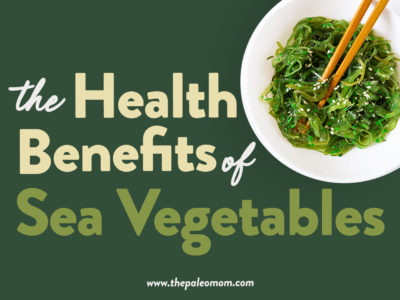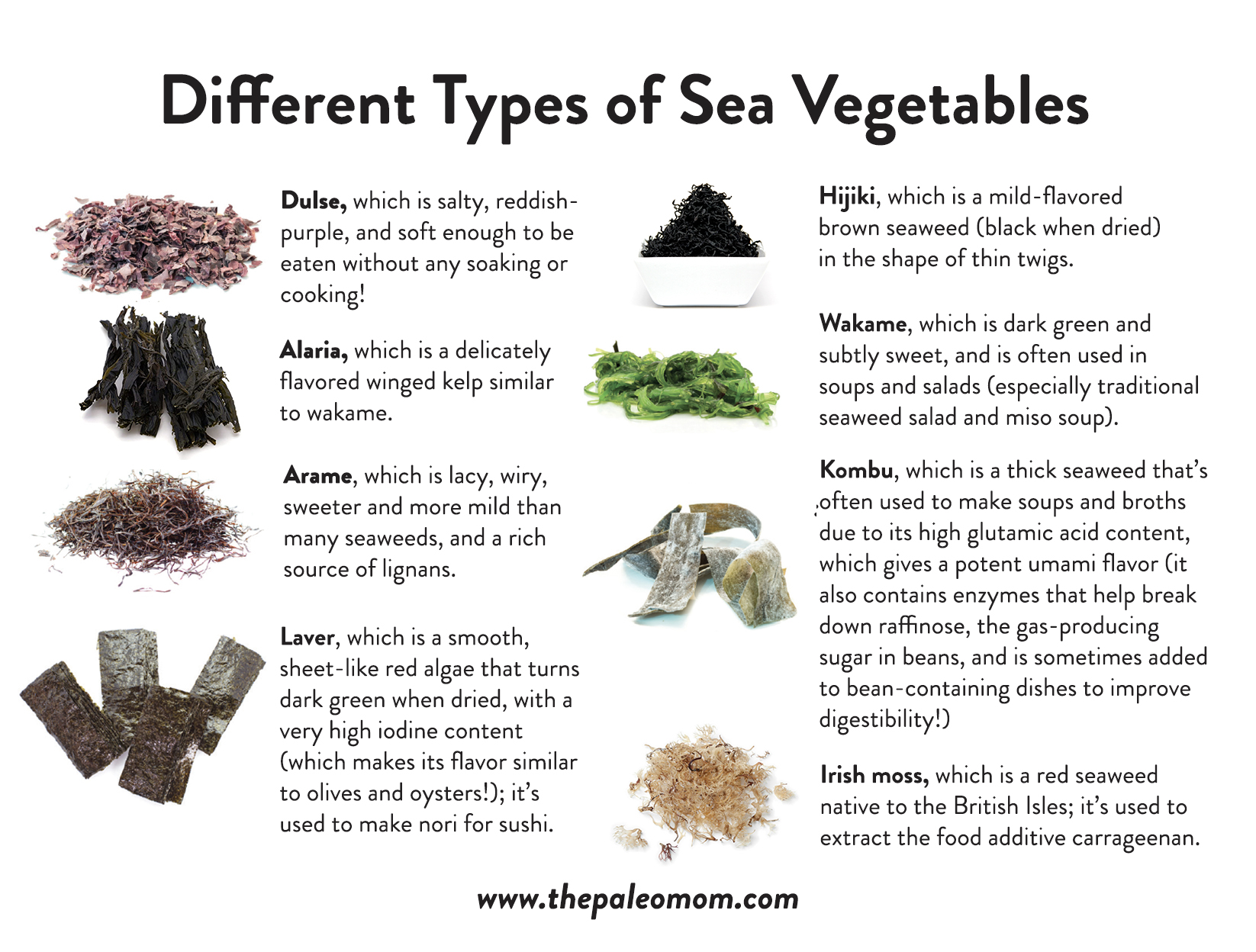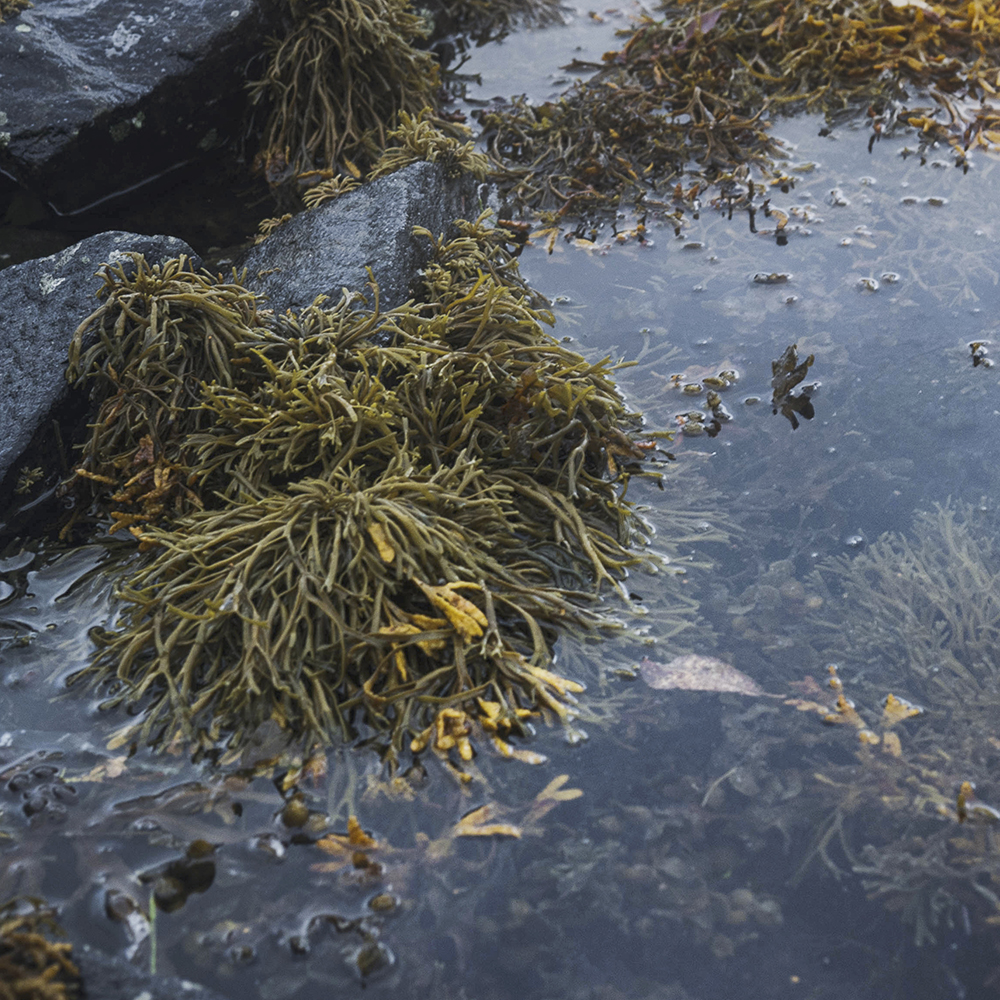 Sea vegetables, also known as edible seaweeds, are not only incredibly tasty, they’re also one of the most unique and nutritious foods on the planet! They’ve been consumed for thousands of years in coastal areas like Japan (where seaweed residue has been found in clay pots dating back to 3000 BC!), and in one of Japan’s earliest legal codes (the Taiho Code of in the 8th century AD), were even legislated to be an acceptable form of tax payment. And, the pink color we see in salmon and flamingos? That comes from astaxanthin, a naturally occurring carotenoid in the algae they eat (or in the case of flamingos, shrimp that eat the algae first!). In fact, captive flamingos will turn white if their diet isn’t supplemented with the levels of astaxanthin they eat in the wild!
Sea vegetables, also known as edible seaweeds, are not only incredibly tasty, they’re also one of the most unique and nutritious foods on the planet! They’ve been consumed for thousands of years in coastal areas like Japan (where seaweed residue has been found in clay pots dating back to 3000 BC!), and in one of Japan’s earliest legal codes (the Taiho Code of in the 8th century AD), were even legislated to be an acceptable form of tax payment. And, the pink color we see in salmon and flamingos? That comes from astaxanthin, a naturally occurring carotenoid in the algae they eat (or in the case of flamingos, shrimp that eat the algae first!). In fact, captive flamingos will turn white if their diet isn’t supplemented with the levels of astaxanthin they eat in the wild!
Table of Contents[Hide][Show]
- Nutrients in Sea Vegetables
- Anti-Inflammatory Effects of Seaweed
- Seaweed May Fight Heart Disease
- Seaweed for Cancer Prevention and Treatment
- Antiviral Properties of Seaweed
- Gut Health Benefits
- What About Heavy Metal Toxicity?
- Algae Might NOT Be Awesome
- What About the Mucilage?
- That All Sounds Great… But How Do We Eat The Stuff?!
- Citations
Most of us are familiar with the nori that wraps sushi rolls, but the list of edible seaweeds definitely doesn’t end there. Other sea vegetables include:
- Dulse, which is salty, reddish-purple, and soft enough to be eaten without any soaking or cooking!
- Alaria, which is a delicately flavored winged kelp similar to wakame
- Arame, which is lacy, wiry, sweeter and more mild than many seaweeds, and a rich source of lignans
- Laver, which is a smooth, sheet-like red algae that turns dark green when dried, with a very high iodine content (which makes its flavor similar to olives and oysters!); it’s used to make nori for sushi
- Hijiki, which is a mild-flavored brown seaweed (black when dried) in the shape of thin twigs
- Wakame, which is dark green and subtly sweet, and is often used in soups and salads (especially traditional seaweed salad and miso soup)
- Kombu, which is a thick seaweed that’s often used to make soups and broths due to its high glutamic acid content, which gives a potent umami flavor (it also contains enzymes that help break down raffinose, the gas-producing sugar in beans, and is sometimes added to bean-containing dishes to improve digestibility!)
- Irish moss, which is a red seaweed native to the British Isles; it’s used to extract the food additive carrageenan
Nutrients in Sea Vegetables
Plenty of vegetables have impressive nutritional résumés, but seaweeds really take the cake (er, the salad)! Although each variety of seaweed has a different overall profile of vitamins and minerals, in general, you can expect these foods to be rich in:
- Iodine
- Calcium
- Magnesium
- Iron
- Potassium
- Phosphorus
- Manganese
- Copper
- Chromium
- Zinc
- Selenium
- Vitamin C
- Vitamin E
- Vitamin K
- B vitamins (B1, B2, B3, B5, and B6)
- Dozens of additional trace minerals! (this may be one of the more compelling reasons to include seaweed in our diets as many of these important minerals are hard to find in the modern food supply)
- In the case of algae, DHA (an omega-3 fat not found in many plant foods)
- Sea vegetables are also one of the few food sources of vanadium—a lesser-known mineral that may play a role in improving insulin sensitivity and decreasing glucose production. (Seaweeds require vanadium for the function of their haloperoxidases—enzymes that play a role in their biological defense and possibly iodide uptake)
Notably, kombu has the highest iodine content among the edible seaweeds—an average of over 2500 micrograms of iodine per gram of seaweed, with wakame coming in a distant second (140 micrograms per gram).
On top of all that, seaweeds have some special components that aren’t found in any land-based vegetables, and which may be responsible for some of their unique health benefits:
- Fucoxanthin, a type of carotenoid that gives seaweeds a brown pigment, and which has potent anti-cancer properties, the ability to reduce liver fat and liver enzymes, and the potential to boost metabolic rate and assist in fat loss!
- Astaxanthin, another carotenoid that’s been linked to improved skin health, cardiovascular health, joint health, and reduced cancer risk.
- Fucoidans and laminarins, sulfated polysaccharides that have been shown to induce cell death of certain cancers (such as lymphoma), have antiviral and neuroprotective properties, help slow blood clotting, improve osteoarthritis via anti-inflammatory effects, and may help modulate the immune system (although in most of these cases, more research in humans is needed to know for sure).
- Alginates, cell-wall constituents of brown algae that may help in weight loss, glycemic control, and appetite regulation.
Anti-Inflammatory Effects of Seaweed
Numerous studies have shown that some components in seaweed help fight inflammation! The fucoxanthin in seaweed is the biggie here: it can inhibit nitric oxide synthase (iNOS) and cyclooxygenase 2 (COX-2) protein expressions, and also suppress the production of a variety of inflammatory cytokines (like IL-1β, TNF-α, and IL-6). That might sound like a lot of complicated science, but basically, it just means that the carotenoid in seaweed can tank pro-inflammatory mediators and help reduce excessive inflammation in the body. (Of course, that has a risk-lowering effect for the numerous conditions that stem from chronic inflammation, too!)
Seaweed May Fight Heart Disease
Among seaweed’s many perks is the potential to cardiovascular health! The antioxidant and anti-inflammatory properties of fucoxanthin can help thwart multiple processes involved in the progression of heart disease, while also modulating immune function. And, research has shown that a many seaweeds have hypolipidemic (lipid-lowering) activity, helping reduce levels of triglycerides and LDL cholesterol. And, the DHA found in algae and algal oil can not only reduce triglycerides and LDL cholesterol, but also raise HDL cholesterol—which, collectively, paint a more favorable picture for combating heart disease!
Seaweed for Cancer Prevention and Treatment
 In Traditional Chinese Medicine and Japanese folk medicine, seaweeds have long been used to treat tumors, and Western science is beginning to discover why! Multiple studies have shown that seaweed can increase apoptosis (programmed death) of tumor cells, prevent the growth of new blood vessels that supply tumors, inhibit tumor cell adhesion, and prevent metastasis. Whew! That’s a pretty impressive lineup, huh? And, even small amounts of seaweed seem to have a big effect. In one study of postmenopausal women, consuming just 5 grams of brown seaweed each day resulted in a 50% drop in a type of receptor that’s over-expressed in cancer (urokinase-type plasminogen activator receptor, or uPAR, which is involved in multiple signaling pathways, cell adhesion, inflammation, immune function activation, tissue repair, and a number of other functions). The key players behind seaweed’s anti-cancer effects may be its fucoxanthin content, its polyphenolic compounds, its sulfated polysaccharides (fucoidan and laminarin), its ability to increase the colon’s protective mucus bilayer, and its ability to bind dietary toxins and carcinogens by increasing stool bulk.
In Traditional Chinese Medicine and Japanese folk medicine, seaweeds have long been used to treat tumors, and Western science is beginning to discover why! Multiple studies have shown that seaweed can increase apoptosis (programmed death) of tumor cells, prevent the growth of new blood vessels that supply tumors, inhibit tumor cell adhesion, and prevent metastasis. Whew! That’s a pretty impressive lineup, huh? And, even small amounts of seaweed seem to have a big effect. In one study of postmenopausal women, consuming just 5 grams of brown seaweed each day resulted in a 50% drop in a type of receptor that’s over-expressed in cancer (urokinase-type plasminogen activator receptor, or uPAR, which is involved in multiple signaling pathways, cell adhesion, inflammation, immune function activation, tissue repair, and a number of other functions). The key players behind seaweed’s anti-cancer effects may be its fucoxanthin content, its polyphenolic compounds, its sulfated polysaccharides (fucoidan and laminarin), its ability to increase the colon’s protective mucus bilayer, and its ability to bind dietary toxins and carcinogens by increasing stool bulk.
Nutrivore Weekly Serving Matrix
An easy-to-use and flexible weekly checklist
to help you maximize nutrient-density.
The Weekly Serving Matrix is very helpful! I’ve been eating along these lines but this really helps me know where to focus vs. which foods serve a more secondary role. It’s super helpful and has taken a lot of worry out of my meal planning. Thanks!
Jan
And, sea vegetables may be particularly beneficial for lowering the risk of estrogen-related cancers. In a small but fascinating case study of three menopausal women, intake of brown kelp was associated with a significant increase in menstrual cycle length and lower estrogen and higher progesterone levels—all factors that would result in lower estrogen exposure over the course of life, potentially helping protect against certain cancers in women who are estrogen-sensitive. In fact, the traditional use of seaweed in some parts of Asia (like Japan) may help explain why those areas have much lower rates of certain cancers (especially breast cancer) than most Westernized nations!
Antiviral Properties of Seaweed
Another incredible feature of seaweed is its antiviral potential. The sulfated polysaccharides in seaweed can block the interaction between many viruses and host cells—including important pathogens like HIV, herpes simplex, dengue virus, respiratory syncytial virus, and human cytomegalovirus. And, seaweed appears to contain other antiviral components that are enhanced by light (especially UVA) and not only protect our cells, but can directly inactivate the virus particles themselves. How cool is that?
Gut Health Benefits
That’s right: on top of everything else, seaweed is a gut health superfood!
 For one, sea vegetables are rich sources of prebiotic compounds, including unique dietary fibers and polyphenols. They contain up to 71.4% complex polysaccharides such as alginate, laminarin, and fucoidan in brown seaweeds, xylan and sulphated galactans (such as carrageenan, porphyran, and agar) in red seaweeds, and xylan and ulvan in green seaweeds. These polysaccharides have different structures compared to those in land-based plants, and are remarkably resistant to the body’s digestive enzymes, stomach acid, and GI absorption. And, that means that seaweeds offer particularly potent substrates for bacteria in the gut! In particular, seaweed appears to stimulate the growth of Bacteroides, which degrade complex seaweed glycans (and subsequently allow cross-feeding of other carbohydrates and short-chain fatty acids [SCFAs] for beneficial gut commensals like Bifidobacterium).
For one, sea vegetables are rich sources of prebiotic compounds, including unique dietary fibers and polyphenols. They contain up to 71.4% complex polysaccharides such as alginate, laminarin, and fucoidan in brown seaweeds, xylan and sulphated galactans (such as carrageenan, porphyran, and agar) in red seaweeds, and xylan and ulvan in green seaweeds. These polysaccharides have different structures compared to those in land-based plants, and are remarkably resistant to the body’s digestive enzymes, stomach acid, and GI absorption. And, that means that seaweeds offer particularly potent substrates for bacteria in the gut! In particular, seaweed appears to stimulate the growth of Bacteroides, which degrade complex seaweed glycans (and subsequently allow cross-feeding of other carbohydrates and short-chain fatty acids [SCFAs] for beneficial gut commensals like Bifidobacterium).
Brown seaweed has been shown to stimulate the growth of populations of Bifidobacterium, Lactobacillus, Roseburia, Bacteroidetes, Coprococcus, Faecalibacterium, Parasutterella, and Fusicatenibacter, along with increasing production of acetate, butyrate, propionate, and total SCFAs. In one rat study, one week of supplementation with a species of kelp called Ecklonia radiata significantly increased levels of the butyrate-producer Faecalibacterium prausnitzii (when the seaweed’s polysaccharide fraction was used) and lowered levels of potentially pathogenic Enterococcus (when whole, dried seaweed was used). In addition, the seaweed and its polysaccharides reduced harmful protein fermentation products, increased stool bulk, and enhanced levels of SCFAs.
Alginate supplementation has been shown to enhance Bifidobacterium populations in human volunteers, along with significantly increasing acetate and propionate production. Fucoidan extracted from the seaweed Laminaria japonica enhanced the growth of Bifidobacterium and Lactobacillus.
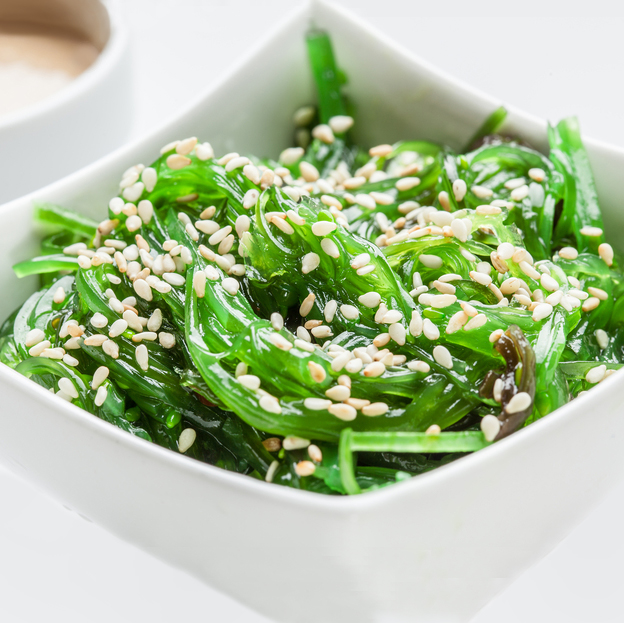 Another study looked at how fiber from raw versus heat-treated brown seaweed (Laminaria japonica, which is over 50% fiber!) changed the relative abundance of bacterial species in the gut. For sixteen weeks, rats were fed one of four diets: a control diet, or the same control diet supplemented with dried seaweed, heat-treated dried seaweed, or heat-treated dried seaweed plus added fructooligosaccharides. Compared to the raw seaweed group, the heat-treated seaweed groups showed significantly lower levels of obesity-associated genera (including Allobaculum, Turicibacter, and Oscillibacter), although all seaweed groups saw a reduction in these genera compared to the control group (along with an increase in leanness-associated genera Alistipes, Bacteroides, and Prevotella). Furthermore, only the heat-treated seaweed group saw an absence of the potential pathogen Escherichia, and only the raw seaweed group saw a statistically significant increase in levels of Lactobacillus. Although all seaweeds offered some benefits over the seaweed-free control diet, the unique changes resulting from whether the seaweed was raw or heated supports the idea that a varied diet—containing both cooked and raw plant foods—will give us the best of all worlds!
Another study looked at how fiber from raw versus heat-treated brown seaweed (Laminaria japonica, which is over 50% fiber!) changed the relative abundance of bacterial species in the gut. For sixteen weeks, rats were fed one of four diets: a control diet, or the same control diet supplemented with dried seaweed, heat-treated dried seaweed, or heat-treated dried seaweed plus added fructooligosaccharides. Compared to the raw seaweed group, the heat-treated seaweed groups showed significantly lower levels of obesity-associated genera (including Allobaculum, Turicibacter, and Oscillibacter), although all seaweed groups saw a reduction in these genera compared to the control group (along with an increase in leanness-associated genera Alistipes, Bacteroides, and Prevotella). Furthermore, only the heat-treated seaweed group saw an absence of the potential pathogen Escherichia, and only the raw seaweed group saw a statistically significant increase in levels of Lactobacillus. Although all seaweeds offered some benefits over the seaweed-free control diet, the unique changes resulting from whether the seaweed was raw or heated supports the idea that a varied diet—containing both cooked and raw plant foods—will give us the best of all worlds!
Along with its fiber, the specific phytonutrients in seaweed are responsible for some of its gut health effects! For example, in mice, the carotenoid astaxanthin has been shown to increase the abundance of Akkermansia muciniphila, a type of bacteria that’s been inversely associated with diabetes, inflammation, obesity, and metabolic disorders (in . In mice with diet-induced obesity, seaweed-derived astaxanthin can regulate lipid metabolism and prevent weight gain by altering the gut microbiota—in particular, improving the Bacteroides/Firmicutes ratio and increasing the proportion of Verrucomicrobia, the phylum that contains Akkermansia.
Along with boosting levels of “good” bacteria, sea vegetables can reduce levels of some of the bad guys. In animal models, fucoidan derived from brown seaweed was able to inhibit H. pylori from attaching to the gastric mucin, suggesting a role for preventing infection with this bacteria (H. pylori is responsible for stomach ulcers and increases the risk of gastric cancer!).
What About Heavy Metal Toxicity?
As with any food that comes from the ocean, there’s some concern about seaweed accumulating heavy metals from polluted waters. Fortunately, a number of researchers and seaweed manufacturers have begun testing seaweed samples to ensure safety, and to identify any high-risk seaweed species!
The good news is, only one type of seaweed has consistently shown up as dangerous: hijiki, which frequently tests high for arsenic. Other types of seaweed (especially ones harvested or imported into the US) generally contain levels of heavy metals so low that even an extremely high seaweed intake would still be fine.
But, just to be safe, it’s smart to buy seaweeds from companies that perform regular testing on their products to ensure low levels of any dangerous contaminants.
Algae Might NOT Be Awesome
 Algae, such as chlorella and spirulina (typically found in supplements but also in prepackaged green juices), differ from their seaweed cousins in many ways. In particular, they are single-celled organisms as opposed to the multi-cellular seaweeds.
Algae, such as chlorella and spirulina (typically found in supplements but also in prepackaged green juices), differ from their seaweed cousins in many ways. In particular, they are single-celled organisms as opposed to the multi-cellular seaweeds.
There is evidence that chlorella, which is a freshwater green algae, contains lipopolysaccharide in its cell membrane. Lipopolysaccharide, also called endotoxin, is the same toxic protein in the cell walls of Gram-negative bacteria like Escherichia coli. It has also been shown to increase inflammation and stimulate Th1 cells.
Spirulina is commonly referred to as a blue-green algae, but it’s actually a Gram-negative, non-toxic species of cyanobacteria. It grows in saltwater lakes in Mexico and Africa. Spirulina also contains lipopolysaccharide in its cell membrane; and studies show that it activates the innate immune system (causing inflammation) and stimulates Th1 cells. Other studies show that it may suppress Th2 cells as well.
While seaweed is amazing, the same can’t necessarily be said of algae due to immune stimulating properties.
What About the Mucilage?
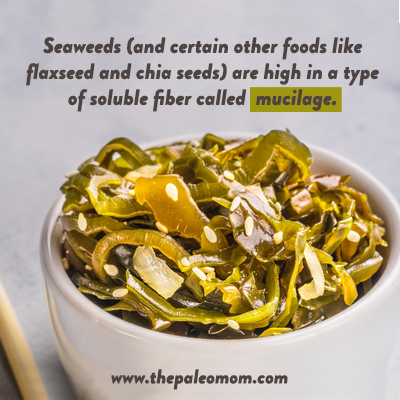 As I wrote about in a previous post, seaweeds (and certain other foods like flaxseed and chia seeds) are high in a type of soluble fiber called mucilage. This fiber has legitimate health-boosting effects (especially for gut hea\lth), but can also stimulate the immune system (both Th1 and Th2, depending on the source of the mucilage)—making it potentially problematic for certain people with autoimmune conditions. And, because mucilage can be hydrolyzed into simple sugars like xylose, glucose, rhamnose, and galactose, pathogenic bacteria (like Clostridium difficile and Escherichia coli) can potentially thrive.
As I wrote about in a previous post, seaweeds (and certain other foods like flaxseed and chia seeds) are high in a type of soluble fiber called mucilage. This fiber has legitimate health-boosting effects (especially for gut hea\lth), but can also stimulate the immune system (both Th1 and Th2, depending on the source of the mucilage)—making it potentially problematic for certain people with autoimmune conditions. And, because mucilage can be hydrolyzed into simple sugars like xylose, glucose, rhamnose, and galactose, pathogenic bacteria (like Clostridium difficile and Escherichia coli) can potentially thrive.
For people who already have over-stimulated immune systems, the best bet is to avoid the highest-mucilage seaweeds (especially kombu and agar agar) and stick to varieties lower in mucilage, such as dulse, and avoid isolated mucilage fibers (found in some supplements). There are so many amazing benefits to seaweeds that they’re really not worth cutting out of our diets completely unless they’re clearly aggravating an existing health problem!
That All Sounds Great… But How Do We Eat The Stuff?!
So, how can we incorporate more of this amazing food into our diets? Here are some ideas!
- Make a delicious seaweed salad
- Use dulse flakes as a salty, flavorful seasoning
- Put strips of seaweed such as kombu into soups and stews
- Switch to a salt enriched with sea vegetables
- Mix soaked, softened seaweeds into land-vegetable salads for a unique flavor addition
- Make your own sushi with nori
- Look for seaweed snacks at the health food store (made with olive oil, not corn oil—check the ingredients!)
- Mix dulse flakes into a salad dressing
Also, some components of seaweed (particularly fucoxanthin) require dietary fat to be best absorbed, so consuming seaweed in a meal with a fat-rich food (like avocado, olive oil, or sesame oil if you tolerate it) will enhance the nutritional perks!
All in all, seaweed is truly a powerhouse in terms of nutrition and health-promoting compounds. Enjoy this gift from the sea in whichever ways your taste buds prefer!
Citations
Ara J, et al. “Hypolipidaemic activity of seaweed from Karachi coast.” Phytother Res. 2002 Aug;16(5):479-83.
Armstrong PB, et al. Immunohistochemical demonstration of a lipopolysaccharide in the cell wall of a eukaryote, the green alga, Chlorella. Biol Bull. 2002 Oct;203(2):203-4.
Bernstein AM, et al. “A Meta-Analysis Shows That Docosahexaenoic Acid from Algal Oil Reduces Serum Triglycerides and Increases HDL-Cholesterol and LDL-Cholesterol in Persons without Coronary Heart Disease.” J. Nutr. 2012 Jan;142(1):99-104.
Charoensiddhi S, et al. “Gut health benefits of brown seaweed Ecklonia radiata and its polysaccharides demonstrated in vivo in a rat model.” Journal of Functional Foods. 2017 Oct;37:676-684.
Cherry P, et al. “Prebiotics from Seaweeds: An Ocean of Opportunity?” Mar Drugs. 2019 Jun 1;17(6):327. doi: 10.3390/md17060327.
Damonte EB, et al. “Sulfated seaweed polysaccharides as antiviral agents.” Curr Med Chem. 2004 Sep;11(18):2399-419.
Heo SJ, et al. “Evaluation of anti-inflammatory effect of fucoxanthin isolated from brown algae in lipopolysaccharide-stimulated RAW 264.7 macrophages.” Food Chem Toxicol. 2010 Aug-Sep;48(8-9):2045-51.
Hsu HY, et al. Immunostimulatory bioactivity of algal polysaccharides from Chlorella pyrenoidosa activates macrophages via Toll-like receptor 4. J Agric Food Chem. 2010 Jan 27;58(2):927-36.
Hwang YO, et al. “Total arsenic, mercury, lead, and cadmium contents in edible dried seaweed in Korea.” Food Addit Contam Part B Surveill. 2010;3(1):7-13.
Jensen GM, et al. “Effect of alginate supplementation on weight loss in obese subjects completing a 12-wk energy-restricted diet: a randomized controlled trial.” Am J Clin Nutr. 2012 Jul;96(1):5-13.
Kang SM, et al. “Molecular docking studies of a phlorotannin, dieckol isolated from Ecklonia cava with tyrosinase inhibitory activity.” Bioorg Med Chem. 2012 Jan 1; 20(1):311-6.
Konishi I, et al. “Halocynthiaxanthin and fucoxanthinol isolated from Halocynthia roretzi induce apoptosis in human leukemia, breast and colon cancer cells.” Comp Biochem Physiol C Toxicol Pharmacol. 2006 Jan-Feb;142(1-2):53-9.
Kotake-Nara E, et al. “Antiproliferative effect of neoxanthin and fucoxanthin on cultured cells.” Fish Sci. 2005;71:459–461.
Koyanagi S, et al. “Oversulfation of fucoidan enhances its anti-angiogenic and antitumor activities.” Biochem Pharmacol. 2003 Jan 15;65(2):173-9.
Liu JM, et al. “Inhibitory effect of fucoidan on the adhesion of adenocarcinoma cells to fibronectin.” Anticancer Res. 2005 May-Jun;25(3B):2129-33.
Løbner M, et al. Enhancement of human adaptive immune responses by administration of a high-molecular-weight polysaccharide extract from the cyanobacterium Arthrospira platensis. J Med Food. 2008 Jun;11(2):313-22.
Maruyama H, et al. “The role of NK cells in antitumor activity of dietary fucoidan from Undaria pinnatifida sporophylls (Mekabu).” Planta Med. 2006 Dec; 72(15):1415-7.
Miao HQ, et al. “Inhibition of heparanase activity and tumor metastasis by laminarin sulfate and synthetic phosphorothioate oligodeoxynucleotides.” Int J Cancer. 1999 Oct 29;83(3):424-31.
Rose M, et al. “Arsenic in seaweed–forms, concentration and dietary exposure.” Food Chem Toxicol. 2007 Jul;45(7):1263-7.
Shibata H, et al. “Preventive effects of Cladosiphon fucoidan against Helicobacter pylori infection in Mongolian gerbils.” Helicobacter. 2003 Feb;8(1):59-65. doi: 10.1046/j.1523-5378.2003.00124.x.
Skibola CF, et al. “The effect of Fucus vesiculosus, an edible brown seaweed, upon menstrual cycle length and hormonal status in three pre-menopausal women: a case report.” BMC Complement Altern Med. 2004 Aug 4;4:10. doi: 10.1186/1472-6882-4-10.
Son EW, et al. “Antiviral and tumoricidal activities of alginate-stimulated macrophages are mediated by different mechanisms.” Arch Pharm Res. 2003 Nov;26(11):960-6.
Teas J, et al. “The consumption of seaweed as a protective factor in the etiology of breast cancer: proof of principle.” J Appl Phycol. 2013 Jun;25(3):771-779.
Trushina EN, et al. The influence of Spirulina and Selen-Spirulina on some indexes of rat’s immune status. Vopr Pitan. 2007;76(2):21-5.
Wang H, et al. “Antiviral activities of extracts from Hong Kong seaweeds.” J Zhejiang Univ Sci B. 2008 Dec; 9(12): 969–976.
Wang J, et al. “Xanthophyllomyces dendrorhous-Derived Astaxanthin Regulates Lipid Metabolism and Gut Microbiota in Obese Mice Induced by A High-Fat Diet.” Mar Drugs. 2019 Jun 5;17(6):337. doi: 10.3390/md17060337.
Wu L, et al. “Astaxanthin-Shifted Gut Microbiota Is Associated with Inflammation and Metabolic Homeostasis in Mice.” The Journal of Nutrition. 2020 Oct;150(10):2687-2698. DOI: 10.1093/jn/nxaa222.
Yeh TS, et al. “Analysis of iodine content in seaweed by GC-ECD and estimation of iodine intake.” Journal of Food and Drug Analysis. 2014 Jun;22(2):189-196.

